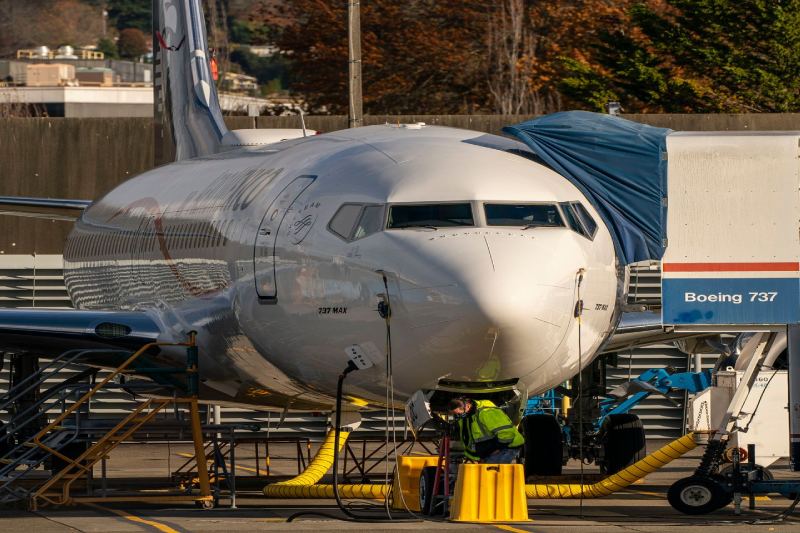Boeing’s 737 MAX 9 aircraft are not taking off again very soon.
A refrigerator-sized hole was created in the aircraft and the cabin quickly lost pressure when a panel on an Alaska Airlines MAX 9 blew off a week ago on Friday. The Federal Aviation Administration announced that the planes would stay grounded until Boeing provided the necessary data, which will take several days to gather.
The 737 MAX 9 aircraft are “parked” at major airports, such as Seattle-Tacoma International Airport, as airlines wait for Boeing to provide inspection guidelines. The FAA must provide its approval to those guidelines. Earlier this week, Boeing filed the initial set of plans, but the same day, they were withdrawn.
The FAA stated on Friday that while it was “encouraged by the exhaustive nature” of Boeing’s instructions, the plans would not be approved until it had examined the information from the initial 40 inspections.
“We are working to make sure nothing like this happens again,” FAA administrator Mike Whitaker said. “Our only concern is the safety of American travelers and the Boeing 737-9 MAX will not return to the skies until we are entirely satisfied it is safe.”
In an additional indication that the aftermath of the fuselage explosion is not over, the airlines flying Boeing’s 737 MAX 9 advised customers to anticipate flight disruptions until the following week. The only two American airlines operating the MAX 9 are Alaska and United Airlines. They have canceled those flights through Tuesday.
Alaska stated it would affect anything from 110 to 150 flights per day, while United predicted that it would affect about 200 flights daily.
“While the MAX 9 won’t fly this weekend, our work continues,” United said in a statement to The Seattle Times. “As we’ve said before, these aircraft won’t fly until they are approved and we are confident they are 100% safe.”
Alaska has started moving some aircraft its 737 MAX 9 fleet to “primary maintenance bases” so that the inspections may start as soon as they receive approval.
The door plug visits D.C.
The day after a section of the fuselage broke off Alaska Flight 1282 at 16,000 feet in the air, the Federal Aviation Administration (FAA) grounded the 737 MAX 9. A door plug that was occupying a space in the aircraft where an emergency exit is built for airlines that place additional seats in the cabin is what flew off.
Instead of using the slot, United and Alaska put a door plug in the area.
The plug is held together when everything functions correctly by tiny brackets that are located on either side of the door frame. The door plug’s twelve comparable stop pads match up with those brackets, which are known as “stop fittings.” The stop pads lock the door stopper in place by pressing against the stop fittings when the passenger cabin is pressured.
The door plug is movable, allowing for maintenance to be done on the aircraft. Additionally, the door stopper is secured in place by four bolts to prevent it from blowing off when it shouldn’t and from happening.
Those bolts are the present focus of the inquiry into the tragedy, which is led by the National Transportation Safety Board.
The NTSB decided that the four bolts intended to keep the 63-pound door plug from moving up were either missing, misinstalled, or broken after inspecting the aircraft and the door plug.
Soon after the incident, the door plug that caused Flight 1282 to blow was discovered close to Portland. It arrived at NTSB’s lab in Washington, D.C., on Friday. There, investigators will search for clues as to what caused it to fly off, such as scratches that would reveal whether or not the bolts were put in.
A week-long examination
Lawmakers and regulators have been very active in the week since the fuselage blew out, especially on Thursday and Friday.
In order to ascertain if Boeing followed with rules intended to guarantee that its aircraft were safe and constructed correctly, the FAA declared on Thursday morning that it would begin an inquiry into the company’s involvement in the event.
Later that day, Sen. Maria Cantwell, a Democrat from Washington, wrote the FAA a letter requesting additional details regarding the agency’s oversight of Boeing. Congress had closely scrutinized the agency’s oversight of Boeing five years prior, following the deaths of 346 people in two MAX crashes.
Cantwell requested to view the last 24 months’ worth of FAA quality systems audit notices pertaining to Spirit AeroSystems, a supplier of Boeing, and the aircraft manufacturer. Spirit, a Wichita, Kansas-based company, completes the 737 MAX 9 fuselage and ships it by rail to Boeing’s Renton facility.
The FAA declared on Friday morning that it will step up its monitoring and audit of Boeing’s 737 MAX 9 production line in addition to the company’s suppliers of parts. Additionally, it is thinking about having an impartial outsider manage Boeing’s quality control and inspection processes.
“It is time to re-examine the delegation of authority and assess any associated safety risks,” Whitaker said in a statement Friday morning. “The grounding of the 737-9 and the multiple production-related issues identified in recent years requires us to look at every option to reduce risk.”
The FAA said on Friday afternoon that it will take some time for them to accept the inspection guidelines needed to bring the aircraft back in the air.
Four days after Boeing announced on Monday that it would provide an updated set of instructions, the airlines had not heard from the company. The FAA ordered the planes to stay grounded until it had examined the data from the initial round of inspections on Friday afternoon.
The duration of those rounds is unknown.
“The safety of the flying public, not speed, will determine the timeline for returning the Boeing 737-9 MAX to service,” the FAA said earlier this week.
Inspections will only be required for MAX 9 models that use door plugs in place of emergency exits.
Libertarian think tank Reason Foundation transportation policy specialist Marc Scribner is awaiting an alternative set of data from Boeing. He is waiting for the company’s answer, which it sent to Boeing executives on Thursday, to the FAA’s letter of investigation.
Within ten business days, Boeing was required by the FAA to reply to a letter it had sent out detailing the “root cause” of the incident, the effects it had on services and goods, and any short- and long-term steps it had taken to fix the issue.
Boeing has pledged to work completely and openly with the FAA and NTSB on both inquiries. The business reaffirmed on Friday that it will assist with the recently disclosed audit.
“We welcome the FAA’s announcement,” Boeing said. “We support all actions that strengthen quality and safety and we are taking actions across our production system.”
Topics #737 MAX 9 #Aircraft #FAA










